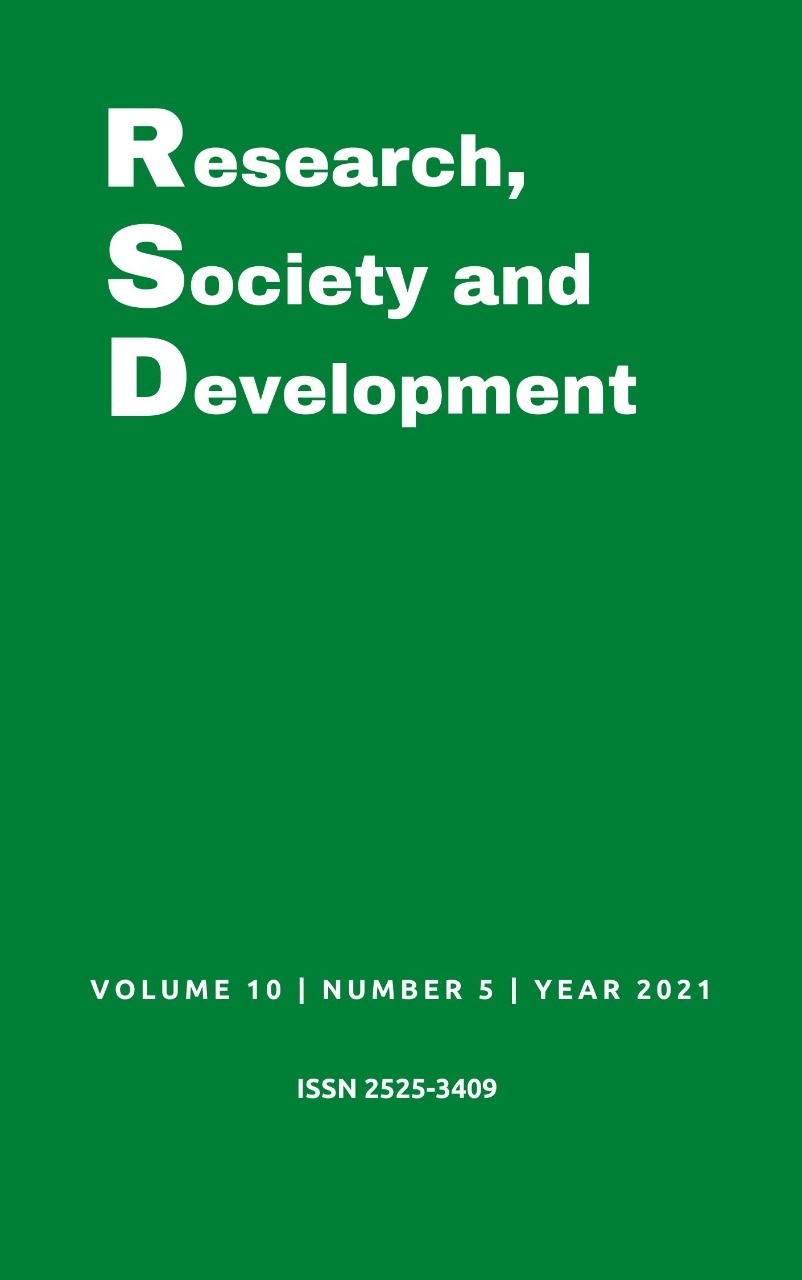Use of Remote Sensing and Geoprocessing to estimate vegetated and non-vegetated areas in the fastest growing neighborhoods in São Luís-MA, during the years 2000 and 2010
DOI:
https://doi.org/10.33448/rsd-v10i5.15013Keywords:
Population growth, Remote rense, Geoprocessing.Abstract
In the city of São Luís do Maranhão there was a population growth of 17% during the years 2000 to 2010. The urban growth resulting from populational growth affects the vegetation cover, in some areas this change may be positive due to the increase in vegetation or negative due to the loss of vegetation. Since the urban expansion directly affects the vegetated areas, it is interesting to carry out a constant mapping of the vegetation cover. Therefore, remote sensing and geoprocessing combined with a Geographic Information System (GIS) can be viable alternatives for studying the vegetative vigor of certain regions through the Normalized Difference Index (NDVI), to estimate the change in the vegetation resulting from the urban expansion between the years 2000 and 2010, in the capital of Maranhão. In this study, we identified the fifteen neighborhoods in the city that achieved the highest population growth, in addition, the neighborhoods were classified according to occupancy patterns. From satellite images from remote sensing, combined with geoprocessing techniques, it was possible to estimate the vegetated and non-vegetated areas of the fastest-growing neighborhoods in the city of São Luís-MA, in the years 2000 and 2010. Seven neighborhoods showed losses of vegetation over the period, another seven showed an increase in vegetation areas, and one neighborhood showed no variation.
References
Almeida, C. M. (2010) Aplicação dos sistemas de sensoriamento remoto por imagens e o planejamento urbano regional. Arq.Urb, (3), 98-123. https://revistaarqurb.com.br/arqurb/article/view/120/106
Almeida, R. V., Araújo, M. D. D. O. G. D., Silva, A. C. D. S., & Senna, J. A. D. (2015). Comparação dos Métodos de Correção Atmosférica: ”6S” e “DOS” processadas em dados do sensor TM/Landsat 5 e correspondentes a região de ocorrência da turfeira P-d-F. Anais XVII Simpósio Brasileiro de Sensoriamento Remoto - SBSR, João Pessoa-PB.
Alves, C. A (2004). Estimativa da área impermeável dentro da bacia do Arroio. Diluvio (Porto alegre - RS) através de técnicas de sensoriamento remoto e geoprocessamento. http://www.ufrgs.br/arroiodiluvio/conteudo-antigo/copy_of_sobre-o-arroio diluvio/estiamtivadaarea.pdf.
Brinkhoff, T., Kriegel, H. P., Schneider, R., & Bernhard, S. (1994). Multi-Step Processing of Spatial Joins. ACM SIGMOD Record. 23. 10.1145/191839.191880. https://www.researchgate.net/publication/33030235_Multi-Step_Processing_of_Spatial_Joins
Coelho, G. T. F., & Sales, L. L. N. (2017) Ocupação do espaço urbano: observações históricas e a expansão da Península da Ponta D’areia em São Luís (MA) entre os anos de 2004 e 2016. Social Evolution. https://doi.org/10.6008/SPC2595-430X.2017.001.0002
Diogo, R. F. (2016). Avaliação de Metodologias de correção da reflectância do topo da atmosfera para Landsat 8 Oli. Universidade Tecnológica Federal do Paraná. Campo Mourão-PR: http://repositorio.utfpr.edu.br/jspui/handle/1/7003
Defesa Civil de São Luís – MA (2019). Pontos de risco de São Luís. São Luís.
IBGE (2021). Instituto Brasileiro E Geografia E Estatística. Cidades. http://www.ibge.gov.br
INCID. (2010) Instituto da Cidade, Pesquisa e Planejamento Urbano e Rural. https://www.agenciasaoluis.com.br/site/arquivodacidade/2239
Leite, G. T. D., Pinheiro, R. Z. G., & Pamboukian, S. V. D. (2019). Monitoramento de áreas de risco com a utilização de técnicas de geoprocessamento. Revista Mackenzie de Engenharia e Computação, v. 19, n. 1, p. 28-47. São Paulo-SP.
Louzeiro, A. D. S. (2018) Vulnerabilidade e risco de movimento de massa no município de São Luís - MA (Brasil). https://repositorio.ufrn.br/jspui/bitstream/123456789/25405/1/Vulnerabilidaderiscom ovimento_Louzeiro_2018.pdf.
Machado, C. A S. (2013) Técnicas de sensoriamento remoto para identificação de áreas de concentração de polos geradores de viagens. https://www.teses.usp.br/teses/disponiveis/3/3138/tde-14052014-152928/pt-br.php
Meneses, P. M., & Almeida, T. D. (2012). Introdução ao processamento de imagens de Sensoriamento remoto. http://www.cnpq.br/documents/10157/56b578c4-0fd5-4b9f-b82a-e9693e4f69d8
Moreira, A.M. (2003). Fundamentos do Sensoriamento Remoto e Metodologias de Aplicação. Editora UFV, 2a Ed., Viçosa MG.
Nunes, F. F., & Roig, H. L (2014). Análise e mapeamento do uso e ocupação do solo da bacia do Alto do Descoberto, DF/GO, por meio de classificação automática baseada em regras e lógica nebulosa. Revista Árvore. http://dx.doi.org/10.1590/0100-67622015000100003.
Pamboukian, P. D. (2015). Classificação supervisionada. https://www.mackenzie.br/fileadmin/OLD/62/ARQUIVOS/PUBLIC/user_upload/_imported/fileadmin/LABGEO/Curso/09._Aula_09/0901._Classificacao_supervisionada.pdf
Pereira, A.S., Shitsuka, D.M., Parreira, F.J., & Shitsuka, R. (2018). Metodologia da pesquisa científica. Editora UAB/NTE/UFSM. Santa Maria-RS
Ponzoni, F. J., Shimabukuro, Y. E., & Kuplich, T. M (2012) Sensoriamento remoto no estudo da vegetação. Oficina de Textos, 2a Ed, São José dos Campos-SP
Rosário, R.C., & Araújo R.C. (2019). Estudo da expansão urbana da cidade de São Luís-MA. Revista Engenharia e Tecnologia. https://www.revistas2.uepg.br
Secretária de Saúde do Estado do Maranhão. (2021). https://www.saude.ma.gov.br/
Silva, J. S., & Silva, R. M. (2016). Mapeamento e comparação entre índices de vegetação utilizando imagem OLI/Landsat 8 na bacia do Rio Bacanga, São Luís (MA). XVII Encontro de Geógrafos. São Luís, Maranhão, Brasil.
Downloads
Published
Issue
Section
License
Copyright (c) 2021 Ronald Costa Garcia; Rodrigo da Cruz de Araujo

This work is licensed under a Creative Commons Attribution 4.0 International License.
Authors who publish with this journal agree to the following terms:
1) Authors retain copyright and grant the journal right of first publication with the work simultaneously licensed under a Creative Commons Attribution License that allows others to share the work with an acknowledgement of the work's authorship and initial publication in this journal.
2) Authors are able to enter into separate, additional contractual arrangements for the non-exclusive distribution of the journal's published version of the work (e.g., post it to an institutional repository or publish it in a book), with an acknowledgement of its initial publication in this journal.
3) Authors are permitted and encouraged to post their work online (e.g., in institutional repositories or on their website) prior to and during the submission process, as it can lead to productive exchanges, as well as earlier and greater citation of published work.


